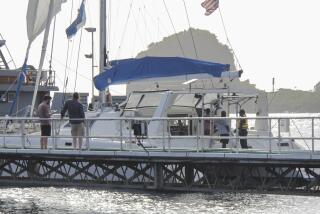Family Fears Doctor Who Disappeared Was Waylaid : Mysteries: Pirates may have targeted Robert Axelrod’s power boat, a spokesman says. But experts and officials say few such cases are the work of seagoing criminals.
- Share via
The disappearance of Newhall physician Robert Axelrod, who never returned after going on a cruise in his 30-foot power boat the Aimee, has left family members and friends groping for an explanation to a seemingly unexplainable act.
And in the absence of answers to the mystery surrounding Axelrod’s disappearance Jan. 25, those closest to him say they are beginning to think that seagoing criminals might have waylaid the 43-year-old plastic surgeon.
“These types of things happen more frequently than we’re aware of,” said Marc Jacoby, a spokesman for Axelrod’s wife, Julie.
Axelrod’s powerful boat might have been a tempting target for drug runners who want a fast boat so they can dart into coastal waters, drop off their shipments, then beat it out again before the Coast Guard gets wind of them, friends say.
But is there any evidence that innocent boaters are falling victim to modern-day pirates or drug runners plying the seas off the U. S. coast?
Most experts say there is little hard evidence, despite the popular belief that pirates with automatic weapons are patrolling the coasts of the United States. Still, they concede that crime doesn’t cease at sea.
“We have no pending cases where piracy has occurred,” said Paul Breen, head of the Long Beach office of the FBI, which investigates high seas crime on American flagged vessels anywhere in the world.
“A persistent rumor is that drug smugglers will board recreational boats at sea, murder the crew and take the vessel for smuggling,” a statement by the Coast Guard’s Miami office says. “There are no known cases of this occurring. It would not make sense for smugglers to take a boat which would then become the subject of a Coast Guard search.”
Breen said crime on the high seas is a problem, but not as serious as some fear. In 1989, for instance, the FBI’s 66 field offices recorded 201 serious crimes at sea, of which 149 involved violence. Last year, the total number of crimes had dropped to 149, of which 115 were crimes of violence.
“From my experience, most violations are on larger vessels, merchant or cruise ships,” he said. Typical are the case of a merchant mariner who tried to slit the throat of a fellow sailor while he slept, and the celebrated local case of a newlywed who murdered his wife in 1988 by pushing her overboard while on a cruise. Both men are in federal prison.
Most violence occurs among people on a single ship. There are few cases in which one ship attacks another, which is the typical scenario in a piracy case, Breen said.
Despite these statistics, fears of drug-running pirates kidnaping and murdering pleasure boaters off Florida have become widespread over the years. One federal investigator who previously worked in the yachting industry said passengers frequently would ask whether it was safe to take a boat-based vacation in the Bahamas.
“We always told them yes,” she said, although she admitted that rumors of piracy sometimes spread among her travel industry colleagues as well as the passengers.
Luis Diaz, chief petty officer of the Coast Guard in Miami, said “Miami Vice,” with its images of drug runners spraying the coastal waters with bullets and innocent blood, conveyed the wrong impression.
These days, he said, most drugs are dropped by air near the shore, where they are picked up for transport to the land.
He also said drug runners have little interest in a private boat, even a relatively swift one such as the Aimee.
“They avoid contact with private boaters,” he said.
Rather, they prefer to purchase their own super-fast “cigarette” boats, which can speed along at 50 to 60 knots. Such boats are little more than floating gas cans and cost $250,000 each, but the drug runners can afford them, he said.
“There aren’t very many poor drug runners” who need to steal boats, he said.
Despite these remarks, the Coast Guard’s Washington-based historian, Robert Browning, said it would not be surprising if occasional cases of piracy did occur.
“Of course, in the early portion of American history, there was a lot of piracy,” he said, mainly because of a lack of law enforcement off the shores of the young nation.
But as opposed to the rumors of drug runners, it is more likely that modern hijackers would be after the equipment on board, not the boat itself.
“Marine equipment is so expensive and even a small-sized boat has a lot of equipment on it,” Browning said.
“What they do is take all the equipment off and sink the boat,” he said.
Some cases of missing boaters are never solved. The Coast Guard in Long Beach handles 5,000 cases a year, ranging from investigations of pieces of debris seen floating in the ocean to full-blown searches for missing vessels. If nothing turns up, the search is suspended until there are further developments. In the case of Axelrod, a three-day search discovered only an inflatable life raft from the Aimee.
But the percentage of unsolved cases is fairly low on the West Coast, said Brenda Toledo of the Long Beach Coast Guard office.
“Sooner or later, a body or parts of the boat appear,” she said.
Thousand Oaks private detective Bill Morrison, who was hired by the Axelrod family to look into the disappearance, said some trace of the boat should have been found besides the raft. There were many things on board the Aimee that would float.
But Toledo said that doesn’t mean that the items will be found.
“The ocean is big,” she said.
The life raft found floating in the ocean might indicate that some emergency struck the Aimee, but investigators said it isn’t conclusive of anything.
Perhaps the most hopeful thought for the family and friends of Axelrod is the one with which they most strongly disagree: that he simply departed on his own, maybe to get away from a pressure-filled medical practice for a while.
Police who have experience with missing persons cases do not discount it.
“Most missing persons are missing because they want to be,” Newport Police Sgt. Andy Gonis said. “Most do return.”
Life No Clue in Doctor’s Vanishing
It is the baffling nature of the disappearance of Dr. Robert Axelrod that has caused those closest to him to focus on the possibility of hijacking. Axelrod had gone out that last morning for a shakedown cruise. It was supposed to take about an hour. People who saw him and talked with him on the docks say he seemed fine, happy.
When he failed to return that night, the Coast Guard launched a three-day search, turning up a life raft from his boat, the Aimee, but nothing else.
After the search was suspended, Newport Beach police turned up several leads. A body washed up in Ensenada last week, and a number of news outlets reported that it might be the doctor, despite the fact that there was no firm evidence. The body has since been buried. Police are checking further for an identification.
Also, police have received information from two possible witnesses. One, a Long Beach Fire Department captain, said he saw the Aimee heading into Long Beach Harbor later on Saturday but did not see who was aboard. A motorist reported seeing a boat called the Aimee being towed north on the Ventura Freeway in Camarillo two days later.
Explanations for the disappearance include the possibility that the boat sank, or that Axelrod decided to leave home voluntarily and is taking a vacation somewhere.
But family and friends say that the seas off Newport Harbor were not rough that Saturday and that Axelrod is an experienced boater and scuba diver, so an at-sea accident seems unlikely. Out of hand, they discount the possibility that Axelrod, a popular, 43-year-old plastic surgeon at Holy Cross Medical Center in Mission Hills, may have chosen to disappear for a while.
He was too involved in his life, too excited about the future to pull something like that, they say.
More to Read
Sign up for Essential California
The most important California stories and recommendations in your inbox every morning.
You may occasionally receive promotional content from the Los Angeles Times.













